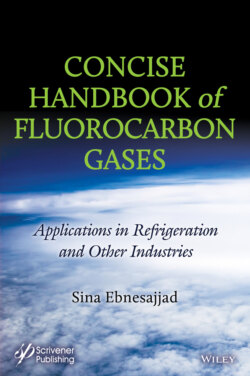Читать книгу Concise Handbook of Fluorocarbon Gases - Sina Ebnesajjad - Страница 16
1.2.2 Fluorocarbon Consumption Demand
ОглавлениеGlobal demand for refrigerants is expected to exceed $30 Billion by 2025 at a compounded annual growth rate (CAGR) of 5.3% from 2018 to 2025. The growth of refrigerants is driven my various factors such as increasing demand of refrigerants in Asia-pacific, increasing demand of cooling products, and growth in global cold chain market. The growing end-user industries such as construction, pharmaceutical, automobile, oil & gas, and food are also driving the refrigerant marke [9].
The fluorocarbon segment is witnessing a slow growth due to stringent environmental regulations such as F-Gas regulation [26, 27], and Montreal Protocol, which demands the phasing out of such harmful gases. Countries such as North America have already started the phasing out of HCFCs and HFCs, due to their harmful effect on environment. These strict regulations provide a wide opportunity to refrigerants such as inorganics and hydrocarbons. Inorganics chemicals have the second largest market share and are also expected to have the highest growth rate between 2015 and 2020.
The Asia-Pacific region remains the largest market for refrigerants, followed by Americas, and Europe, which are comparatively very small market as compared to Asia-Pacific. Asia-Pacific refrigerant market is also expected to witness the highest CAGR of 7.9% from 2015 to 2020. The refrigerants are widely used in various end-user industries such as automobile, construction, chemicals, and oil & gas and these industries are booming in the Asia-Pacific region. Asia Pacific is home to both, the largest and the fastest-growing car markets. Construction is also a key emerging market in Asia-Pacific, which is witnessing a significant growth because of the presence of major economies such as China, India, and Japan [10].
Europe accounted for over 10% of the total demand in 2014 and is anticipated to grow at below average growth rates of over 3% from 2015 to 2022. High usage in applications such as pharmaceutical and household surfactants is expected to drive the demand. The regulations such as waste proposals by EU and adoption of Montreal Protocol are anticipated to slowdown its use in Europe [11].
America’s fluorocarbon refrigerants market was valued at $2.5 billion in 2013 and is estimated to reach $3.1 billion by 2019, at a CAGR of 3.6%, for the given period. The growing demand for chilled and frozen food and beverages has fuelled demand for commercial refrigeration, consequently driving demand for fluorocarbon refrigerants in the region [12]. The global refrigerants market size was US$22.9 billion in 2018 and is projected to reach USD 31.0 billion by 2023, at a CAGR of 6.2% between 2018 and 2023 [13].
Blowing agent application accounted for over 9.5% of the total volume in 2014 and is likely to witness gains at CAGR of over 3% from 2015 to 2024. Fluorochemicals produce hydrogen fluoride, which is broadly used in production of fluorinated hydrocarbons, which serves as foam blowing agents. This is used in wide range of plastics like polystyrene and polyurethane for improving their insulation properties in industrial and domestic appliances such as cooling plants, food processing equipment, refrigerators, cold storage rooms and packaging materials [11].
The largest refrigerant manufacturing countries are China (689,000 metric tons), the USA (604,000 metric tons), Japan (81,000 t metric tons), Germany (32,000 metric tons), India (30,000 metric tons) and the Netherlands (30,000 M tons). The refrigerant quantities produced are not just used in the ventilation, air conditioning and refrigeration technology sector however, but are also used for other industrial processes such as those carried out for aerosols, foams and insulation [14].
The world’s most important refrigerant manufacturers include Arkema, Chemours, Honeywell, Solvay, Daikin, Showa Denko and Mexichem, as well as numerous Chinese manufacturers, some of which are Sinochem Lantian, Shandong Dongya and 3F Fluorochemical Industry, a joint venture between DuPont and Zhonghao New Materials [14].
